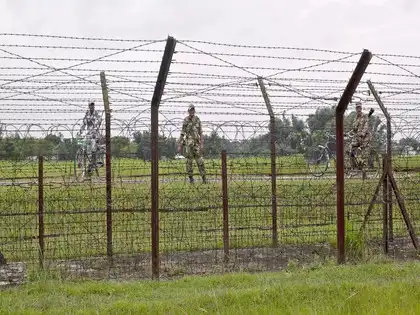
Rishi Suri
The Supreme Court has repeatedly recognised large-scale illegal immigration from Bangladesh as a matter akin to ‘external aggression’ under Article 355, which enjoins the Union to protect states against such threats.
The argument isn’t about compassion; it’s about control.
India is a rules-based democracy with a finite capacity for jobs, housing, and welfare. When cross-border movement takes place outside the law and at scale, it erodes security, distorts local labour markets, and diverts benefits meant for Indian citizens. Nowhere is this more evident than on the India-Bangladesh frontier.
Start with the basics. India shares a 4,096.7 km land border with Bangladesh, the longest of any neighbour. As of early February 2025, the government told Parliament that roughly 3,232 km had been fenced and about 864 km remained (including 175 km of “non-feasible” riverine or difficult terrain). The unfenced gaps are precisely where infiltration, smuggling, and human trafficking concentrate.
.webp) Illegal Bangladeshis rounded up by Police in Surat, Ahmedabad
Illegal Bangladeshis rounded up by Police in Surat, Ahmedabad
The affected states—West Bengal (2,216.7 km), Assam (263 km), Meghalaya (443 km), Tripura (856 km), and Mizoram (318 km)—carry the brunt of these pressures. Apprehensions data underscores the persistence of illegal crossings. In a written reply to the Rajya Sabha on March 12, 2025, the government reported 2,601 Bangladeshi nationals apprehended along the border between January 1, 2024, and January 31, 2025, a month-by-month ledger that shows steady attempts through the year.
Gaping holes
In West Bengal, which hosts more than half of the land boundary, fencing still lags; as late as August 20, 2025, the Centre detailed that only 1,647.7 km of the state’s 2,216.7-km stretch was fenced, with land acquisition delays holding up much of the rest. Those delays are not a technicality; they translate directly into law-and-order stress in border districts.
Security isn’t a rhetorical flourish here; it’s a constitutional obligation. The Supreme Court has repeatedly recognised large-scale illegal immigration from Bangladesh as a matter akin to “external aggression” under Article 355, which enjoins the Union to protect states against such threats. The Court made this clear while striking down the IMDT Act in Sarbananda Sonowal (2005) and revisited the issue in the 2024 judgment on Section 6A (Assam Accord), noting the demographic and security implications of sustained, irregular inflows.
That jurisprudence matters: it frames illegal immigration not as a routine administrative lapse but as a challenge to sovereignty and internal stability.
S Fence on the India-Bangladesh border
Fence on the India-Bangladesh border
Smuggling Route
The humanitarian and legal realities are also complex. India has long hosted people born in Bangladesh; many arrived legally and decades ago. Pew Research, drawing on the UN’s migrant-stock data, estimates about 2.6 million Bangladesh-born residents in India (as of 2020). That figure includes legal and historic migration; it is not a count of “illegal migrants.” The point is that lawful pathways exist and must be protected—precisely why irregular entries need to be deterred and processed transparently.
New Delhi has responded with manpower and technology. The BSF now uses UAVs, night-vision devices, IR sensors, CCTV/PTZ cameras, and the Comprehensive Integrated Border Management System (CIBMS), piloted in particularly difficult riverine sectors like Dhubri in Assam alongside coordinated patrols with Bangladesh’s BGB. These measures are necessary, but not sufficient, so long as critical stretches remain unfenced and legal processes drag.
What, then, should change?
Finish the fence, fix the gaps. The number one priority is to close the remaining 864 km with a combination of physical barriers and smart surveillance where conventional fencing is impossible. That also means fast-tracking land acquisition, notably in West Bengal, through transparent compensation and time-bound approvals. The data is clear: seams in the system map onto hotspots on the ground.

When India showed compassion: Bangladeshi refugees in a camp in India in 1971
Move from episodic drives to systems. Sporadic crackdowns are no substitute for continuous enforcement. The border-tech stack must be scaled, integrated, and sustained—drones tied to analytic dashboards, riverine zones dominated by floating BOPs, and a single operational picture that fuses intelligence, sensors, and patrols in real time. The core idea is deterrence by certainty, not severity.
Check documentation frauds
Tighten the downstream sieve. Illegal entry is only the first breach; the second is document fraud—acquiring ration cards, Aadhaar, or voter IDs to access subsidies or enrol in voter rolls. Robust tenant and worker verification in border districts, API-based de-duplication of welfare beneficiaries, and strict penalties for employers and agents who knowingly hire or traffick irregular migrants would reduce the “pull” factors without racial or religious profiling. (Success here protects public resources for citizens first, while preserving the integrity of lawful migration.
Accelerate due process. Identification, adjudication in Foreigners’ Tribunals, detention where necessary, and deportation require capacity, speed, and fairness. The Court’s line of cases is explicit: the Union has a duty to protect states from the consequences of unchecked illegal migration, but that duty must be discharged within constitutional safeguards. Expanding tribunal benches, digital case-tracking, and legal aid for the indigent can make outcomes faster and less arbitrary.
Coordinate with Dhaka
Work the bilateral levers. Even as Dhaka navigates its own political churn, the BSF-BGB mechanisms and institutional dialogues must stay active—joint patrols, flag meetings, and shared watch-lists. Where India has fenced, inflows fall; where both sides cooperate, smuggling syndicates pay a price. The Home Ministry has flagged these channels; they deserve more resources and political attention.
Finally, let’s be clear about language and law. Illegal immigration is not a proxy for any community. Many Bangladesh-born residents in India are legal and long-settled; many illegal entrants are victims of trafficking or deceit by agents. India can be both firm and fair—firm in guarding its borders and public finances, fair in processing each case humanely and by the book. That balance is the only way to keep the social contract credible: opportunity for those who follow the rules, consequences for those who do not.
ALSO READ: Baharul Islam, the North Star of social work in Greater Bengal
A secure, well-managed border is not anti-migrant; it is pro-citizen and pro-lawful migrant. On the Indo-Bangladesh frontier, getting there means closing the physical gaps, cleaning up the downstream leaks, and enforcing due process at scale, so India’s generosity remains a choice, not an exploit.
This first appeared in Sunday Guardian
